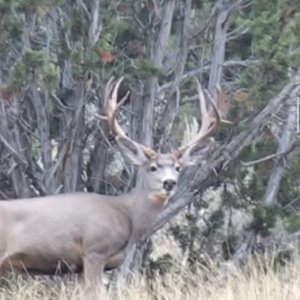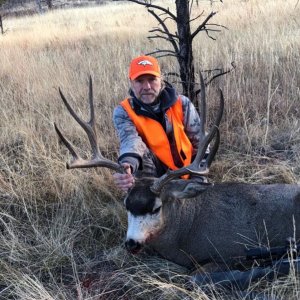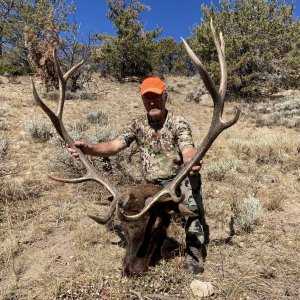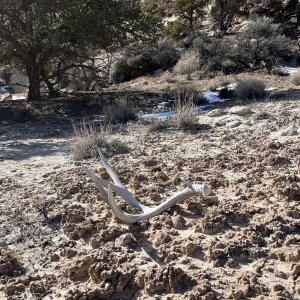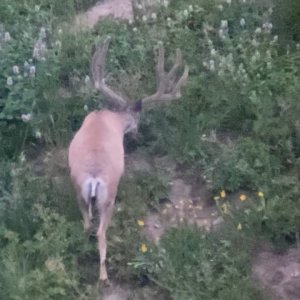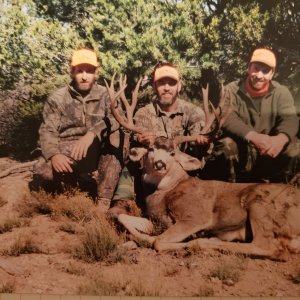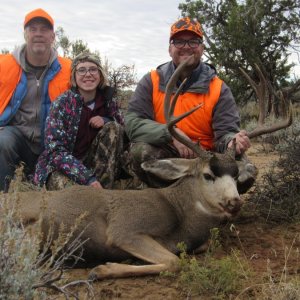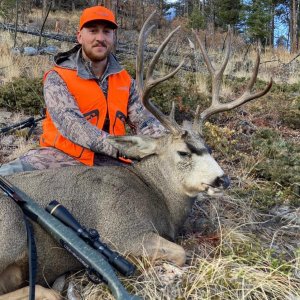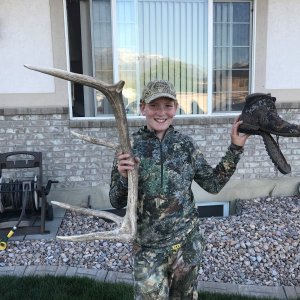BigFin
Active Member
- Messages
- 693
We knew in January that this was happening. Now we have more clues as to the cause. Someone lets their goats out to graze on public land where tens of thousands of dollars and hundreds of volunter hours have been invested to restore a native sheep population, and all of a sudden we have dead sheep all over the place.
Who knows for sure what caused it, but seems strange that the sheep were flourishing until the goats showed up.
Chit! End of sheep hunting in that unit.
I don't think NRs were given the option to apply in this unit, but if you did apply, I suggest changing your app.
WTF.
>>>>>>>>>>>>>>>>>><<<<<<<<<<<<<<<<<<<<<<<<
Helena Independent Record: 4/11/2008
Montana FWP photo - A bighorn sheep rests on a mountainside in this FWP file photo. An all-age die-off has decimated the herd in the Elkhorn Mountains, FWP officials say.
The wild bighorn sheep in the Elkhorn Mountains have suffered an ?all-age die-off,? with only 19 found alive last week.
?If this die-off hadn't occurred, we should have had around 220, plus or minus a few,? said Tom Carlsen, a Fish, Wildlife and Parks biologist. ?This is what we call an all-age die-off, meaning sheep of all ages ? lambs, older adults ? all the animals are affected.
?I'm not aware of any place in Montana where we've had a die-off of this magnitude. We lost over 90 percent of the herd.?
Carlsen said all the sheep that he saw appeared to be healthy.
The die-off was suspected in January, after 12 dead sheep were found. Tests confirm that they suffered from pneumonia, which bighorn sheep can catch through nose-to-nose contact with domestic sheep or goats. The domesticated animals have a built-in immunity to pneumonia, but the disease is fatal for wild bighorns.
Carlsen also confirmed that there was some ?mixing? of the bighorns with at least one domestic herd of sheep, and possibly with a herd
of goats.
The sheep herd owner has a grazing allotment that predates the 1996 FWP effort that involved transplanting 75 bighorn sheep in the hopes of re-establishing a herd in the Elkhorns. Under the state?s policy, this herd owner won't be held accountable for the deaths since he was there first.
?He?s been pretty good to work with,? Carlsen said. ?He has a herder and dogs, and they were pretty effective in chasing the bighorn sheep away.?
Carlsen noted that the bighorns were transplanted at least six miles away from the rancher?s grazing site, but that the younger rams apparently roamed farther during the rut than biologists anticipated.
?Over time, as the herd numbers increased, they wandered closer to the domestic sheep, which surprised us because it wasn?t their kind of habitat,? Carlsen said. ?But the young rams can get kicked out of the ewe groups by older rams.?
However, in the south end of the Elkhorns, someone bought a 20-acre patented mining claim nearly surrounded by public lands and moved in some small trailers and a ?menagerie? of domestic animals including llamas and goats, Carlsen said. Some of the animals run loose, and were seen on public lands, which is illegal without a grazing permit. He said they were about a mile from what's left of the bighorn sheep herd.
Carlsen suspects that those goats, which also can transmit pneumonia to wild sheep, mixed with the bighorns too.
Steve Merritt, information officer for the Department of Livestock, confirmed that their district inspector recently seized about 20-30 stray goats from that area, which were sold at an auction on Monday. The animals were confiscated because they were illegally grazing on public lands.
Carlsen said he doesn't know if they'll transplant additional bighorn sheep to try to shore up the current population, and he's doubtful that the 19 bighorns will be able to grow the size of the herd on their own, so he's not sure what their future holds.
He notes that pneumonia stays in the survivors? systems for a number of years, and it can negatively affect lamb production. In addition, investigations are ongoing as to what causes the pneumonia in the bighorn population, and how it might be better controlled.
?At this point, I don't think we'll be talking about restocking more bighorn sheep in the Elkhorns in the future,? Carlsen said.
Montana has an estimated 5,820 bighorn sheep in 48 distinct populations. The state currently is working on a conservation strategy to increase those numbers and to outline future management plans.
?We'll use this as a learning experience, and it will have some direct input into how we address this issue,? Carlsen said.
Scientists are also trying to figure out why the pneumonia only affects the wild animals, but not the domestic ones that carry the bacteria. Samples were taken from the Elkhorn bighorns, and Carlsen is awaiting those results.
?We want to know not just if they have pneumonia, but what caused it,? Carlsen said. ?Different things can stress the immune system and might make them more susceptible.?
>>>>>>>>>>>>>>>>>>><<<<<<<<<<<<<<<<<<<<<<<<<<<<<<<<<
"Hunt when you can - You're gonna' run out of health before you run out of money!"
Who knows for sure what caused it, but seems strange that the sheep were flourishing until the goats showed up.
Chit! End of sheep hunting in that unit.
I don't think NRs were given the option to apply in this unit, but if you did apply, I suggest changing your app.
WTF.
>>>>>>>>>>>>>>>>>><<<<<<<<<<<<<<<<<<<<<<<<
Helena Independent Record: 4/11/2008
Montana FWP photo - A bighorn sheep rests on a mountainside in this FWP file photo. An all-age die-off has decimated the herd in the Elkhorn Mountains, FWP officials say.
The wild bighorn sheep in the Elkhorn Mountains have suffered an ?all-age die-off,? with only 19 found alive last week.
?If this die-off hadn't occurred, we should have had around 220, plus or minus a few,? said Tom Carlsen, a Fish, Wildlife and Parks biologist. ?This is what we call an all-age die-off, meaning sheep of all ages ? lambs, older adults ? all the animals are affected.
?I'm not aware of any place in Montana where we've had a die-off of this magnitude. We lost over 90 percent of the herd.?
Carlsen said all the sheep that he saw appeared to be healthy.
The die-off was suspected in January, after 12 dead sheep were found. Tests confirm that they suffered from pneumonia, which bighorn sheep can catch through nose-to-nose contact with domestic sheep or goats. The domesticated animals have a built-in immunity to pneumonia, but the disease is fatal for wild bighorns.
Carlsen also confirmed that there was some ?mixing? of the bighorns with at least one domestic herd of sheep, and possibly with a herd
of goats.
The sheep herd owner has a grazing allotment that predates the 1996 FWP effort that involved transplanting 75 bighorn sheep in the hopes of re-establishing a herd in the Elkhorns. Under the state?s policy, this herd owner won't be held accountable for the deaths since he was there first.
?He?s been pretty good to work with,? Carlsen said. ?He has a herder and dogs, and they were pretty effective in chasing the bighorn sheep away.?
Carlsen noted that the bighorns were transplanted at least six miles away from the rancher?s grazing site, but that the younger rams apparently roamed farther during the rut than biologists anticipated.
?Over time, as the herd numbers increased, they wandered closer to the domestic sheep, which surprised us because it wasn?t their kind of habitat,? Carlsen said. ?But the young rams can get kicked out of the ewe groups by older rams.?
However, in the south end of the Elkhorns, someone bought a 20-acre patented mining claim nearly surrounded by public lands and moved in some small trailers and a ?menagerie? of domestic animals including llamas and goats, Carlsen said. Some of the animals run loose, and were seen on public lands, which is illegal without a grazing permit. He said they were about a mile from what's left of the bighorn sheep herd.
Carlsen suspects that those goats, which also can transmit pneumonia to wild sheep, mixed with the bighorns too.
Steve Merritt, information officer for the Department of Livestock, confirmed that their district inspector recently seized about 20-30 stray goats from that area, which were sold at an auction on Monday. The animals were confiscated because they were illegally grazing on public lands.
Carlsen said he doesn't know if they'll transplant additional bighorn sheep to try to shore up the current population, and he's doubtful that the 19 bighorns will be able to grow the size of the herd on their own, so he's not sure what their future holds.
He notes that pneumonia stays in the survivors? systems for a number of years, and it can negatively affect lamb production. In addition, investigations are ongoing as to what causes the pneumonia in the bighorn population, and how it might be better controlled.
?At this point, I don't think we'll be talking about restocking more bighorn sheep in the Elkhorns in the future,? Carlsen said.
Montana has an estimated 5,820 bighorn sheep in 48 distinct populations. The state currently is working on a conservation strategy to increase those numbers and to outline future management plans.
?We'll use this as a learning experience, and it will have some direct input into how we address this issue,? Carlsen said.
Scientists are also trying to figure out why the pneumonia only affects the wild animals, but not the domestic ones that carry the bacteria. Samples were taken from the Elkhorn bighorns, and Carlsen is awaiting those results.
?We want to know not just if they have pneumonia, but what caused it,? Carlsen said. ?Different things can stress the immune system and might make them more susceptible.?
>>>>>>>>>>>>>>>>>>><<<<<<<<<<<<<<<<<<<<<<<<<<<<<<<<<
"Hunt when you can - You're gonna' run out of health before you run out of money!"

